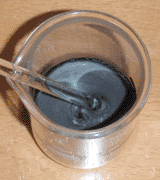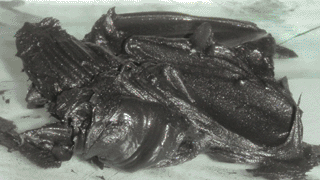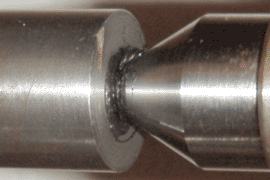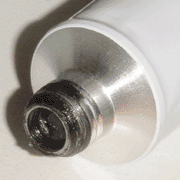



The previous grease works well for most applications; however, some tasks involve more pressure than it can withstand. In these cases the lubricating film is broken, and failure occurs by welding or galling of the contacting surfaces. In commercial greases, this is resolved by complex additives which bind either physically (antiwear additives) or chemically (extreme pressure additives) to the metal surfaces; however, a simpler option is to add a mechanically resilient and lubricating filler, which takes up the impact when a heavy load is placed on the greased components. Historically, both white lead (basic lead carbonate) and black lead (graphite) were used for this purpose; however, due to the toxicity of white lead and the availability of graphite, I decided to use the latter in my experiments.
To make a grease based on this principle, I began by adding 12g of castor oil to a small beaker, to which I added 4g of carnauba wax and 4g of coarse (44µm) flake graphite. I then heated the mixture on a hot plate until the wax began to melt, then stirred it until it became homogeneous and removed it from the heat. After it had cooled to room temperature, I then removed the solid grease from the beaker and mulled it in the usual manner. The resulting grease was very thick, yet still slippery enough to be worked and manipulated without issue. As a qualitative test, I applied some to a dead center on my lathe, which I then used to support a long steel rod. The rod was able to turn smoothly despite significant pressure from the tailstock, so at this point I considered the grease a success, and packed the remainder into a paint tube for storage.
Since the previous grease was intended as a general-purpose lubricant, this new grease could be considered its heavy-duty counterpart. That said, this grease is fully adjustable, and intermediate consistencies can easily be achieved by varying the proportions of wax and graphite according to the desired purpose. As with the last grease, time will determine its stability, but so far it appears to be a suitable lubricant for high-load, low-speed applications.
Interestingly, talc may be used interchangeably with graphite when making this type of grease. Both materials are commonly used as dry lubricants, and are similar in density, softness, and lubricity. Talc grease is particularly useful on wooden components where graphite would cause staining, or on electrical equipment where conductivity may be a concern. Furthermore, both talc and graphite are useful in a wide range of concentrations, intially behaving as anti-wear additives, then also becoming thickeners as their proportion is increased. This thickening effect may also be used for cost reduction (at the expense of increased friction) by lowering the required wax content for a given thickness of grease. Other fillers may also be used to drastically change the purpose of this type of grease. For example, abrasives may be added to soft greases to make polishing or lapping compounds, and pigments may be added to hard greases (mulled into the oil component) to make oil pastels. As with most materials made from simple ingredients, the possibilities are surprisingly endless.